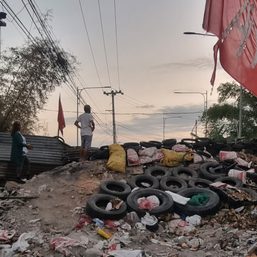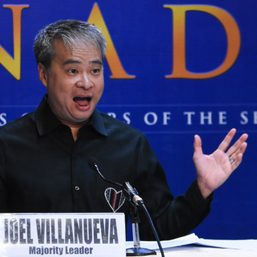The Senate ratified on Thursday, August 20, the Bayanihan to Recover as One Bill (Bayanihan 2) as finalized by both chambers of Congress, alloting a total of P165.5 billion to government efforts to quell the COVID-19 pandemic and buttress the flagging economy.
The measure extends the emergency powers granted to President Rodrigo Duterte by its predecessor, the Bayanihan to Heal as One Act, which lapsed on June 5. If signed into law by Duterte, Bayanihan 2 will be in effect until December 19, when Congress adjourns its session for the year.
Bayanihan 2 is “more about saving jobs and economic recovery,” Senator Sonny Angara told reporters in a virtual briefing.
As head of the Senate finance committee, Angara led the Senate contingent of the bicameral conference committee that reconciled the two congressional chambers’ versions of the proposed measure.
Only P140 billion of the allotted fund will be readily available, as the government has yet to identify revenue sources for the remaining P25.5 billion “standby fund.”
The total allocation narrowly exceeds the P162 billion originally stated in the House of Representatives’ version of Bayanihan 2. The Senate had only allotted P140 billion because it was all the Department of Finance could commit to provide.
Among the highlights of the bicameral-approved Bayanihan 2 bill are:
- P5,000 to P8,000 cash subsidy to low-income households under enhanced community quarantine (ECQ), and to households with recently-returned overseas Filipino workers (OFW)
- P5,000 to P8,000 in unemployment or involuntary separation assistance to displaced workers, including freelancers, the self-employed, and repatriated OFWs
- Special risk allowances, on top of hazard pay, for public and private healthcare workers
- P15,000 cash assistance to healthcare workers who contract a mild or moderate case of COVID-19; P100,000 for healthcare workers with a severe case; P1 million for families of healthcare workers who die of the disease
- P5.6 billion in assistance to displaced public utility vehicle (PUV) drivers, of which P3 billion will be for jeepney drivers
- P10 billion in standby fund for testing and procuring COVID-19 medication and vaccines
- P5 billion to hire 50,000 contact tracers
- A 60-day grace period for the payment of all existing, current, and outstanding loans falling due on or before December 31, 2020
- A minimum 30-day grace period on residential and commercial rents of lessees not permitted to work during the pandemic
- A minimum 30-day grace period for the payment of utility bills (electricity, water, etc) falling due within the period of enhanced community quarantine (ECQ) or modified ECQ
- Suspension of permits to build telecommunication towers, except for the building permit, for 3 years
- Condonation of pending payments of interest, penalties, and surcharges for agrarian reform loans, with the restructuring of the remaining original principal without interest
No ‘ARISE’ provisions
Like its predecessor law, Bayanihan 2 would authorize the President to exercise emergency powers, including to reprogram and realign funds to directly address the health crisis through isolation facilities, field hospitals, medication and vaccines, testing, and subsidies for COVID-19 patients.
The approved measure excludes the provisions establishing the Accelerating Recovery to Intensify Solidarity and Equity or “ARISE” Incorporated. ARISE Inc is a joint venture between the Land Bank of the Philippines and the Development Bank of the Philippines that would invest in private companies as a way to tide them over the economic slump caused by the coronavirus pandemic.
Only the House version of Bayanihan 2 included ARISE Inc. During the bicameral conference, the committee agreed to delete these provisions so that the Senate could hold its own deliberations on the proposed joint venture.
Nevertheless, Senate Minority Leader Franklin Drilon said Bayanihan 2 has a broader coverage than its predecessor.
The following are the general allocations for the P140 billion immediately available fund under Bayanihan 2:
- P13.5 billion for the following health-related items: hiring of emergency “human resources for health,” augmentation for operations of hospitals, monthly special risk allowance, “actual hazard pay,” life insurance, accommodation, transportation, and meals for health workers
- P3 billion to procure personal protective equipment for all local health workers, barangay officials, and “other indigent persons”; preference to be given to local PPE manufacturers
- P4.5 billion for the construction of temporary medical isolation and quarantine facilities, field hospitals, dormitories for frontliners, and the expansion of government hospital capacity nationwide
- P13 billion for cash-for-work programs, and unemployment or involuntary separation assistance for displaced workers, freelancers, the self-employed, and OFWs affected by the government’s deployment ban
- P39.5 billion for capital infusions to government financial institutions (GFI), of which P5 billion is for the credit guarantee program; P18.4 billion for the Land Bank of the Philippines and P6 billion for the Development Bank of the Philippines as equity infusion for low-interest loans for workers and businesses affected by the pandemic; P10 billion for the COVID-19 Assistance to Restart Enterprises (CARES) program of the trade department’s Small Business Corporation (SBCorp), including P6 billion for tourism MSMEs
- P24 billion for direct cash or loan interest rate subsidies to farmers, fisherfolk, agri-fishery enterprises and cooperatives, to finance the Department of Agriculture’s “Plant, Plant, Plant” program
- P9.5 billion to the Department of Transportation, of which P2.6 billion is for critically affected transport businesses; P5.6 billion for temporary livelihood for displaced PUV drivers; P1.3 billion to set up sidewalks and bicycle lanes, and to procure bicycles and other equipment for sharing and lending programs
- P100 million for training and subsidies for tourist guides
- P3 billion to assist state universities and colleges in developing smart campuses through investments in their ICT capabilities
- P600 million for subsidies and allowances of qualified students of public and private schools in all levels, and part-time faculty of state universities and colleges
- P300 million for subsidies and allowances of displaced teaching and non-teaching personnel, including part-time faculty, in all schools in all levels
- P1 billion for the Technical Education and Skills Development Authority’s (TESDA) programs for displaced workers.
- P6 billion for the food and livelihood assistance grants to households in areas on hard lockdown through the Department of Social Welfare and Development (DSWD)
- P4 billion to assist the Department of Education’s digital and alternative learning modalities, including the printing and delivery of self-learning modules
- P1.5 billion in assistance to local government units under the Local Government Support Fund
- P180 million for allowances of national athletes and coaches
- P820 million for the repatriation of OFWs, medical assistance for overseas Filipinos, and the shipment of the remains of those who die of COVID-19
- P4 billion for the tourism industry, of which P1 billion is for tourism infrastructure by the Department of Public Works and Highways (DPWH), and P3 billion to assist displaced tourism sector workers through the Department of Labor and Employment (DOLE). An additional P6 billion for tourism – for soft loans to tourism MSMEs through the Department of Trade and Industry’s (DTI) Small Business Corporation – is lumped into the P39.5 billion allotted for GFIs.
- P4.5 billion to build and maintain isolation facilities, including the billing of hotels, food, and transport used for the COVID-19 response of the Office of Civil Defense as head of the National Task Force against COVID-19
- P5 billion to hire at least 50,000 contact tracers, to be implemented by the Department of the Interior and Local Government
- P2.5 million for the Professional Regulation Commission’s computer-based licensure examination
- P2 billion to subsidize payment of interest on new and exiting loans secured by local government units: P1 billion each from the Land Bank of the Philippines and the Development Bank of the Philippines
- P10 million for the Health Technology Assessment Council research fund to increase COVID-19 research and internal capacity for evidence generation
- P15 million to establish a computational research laboratory in the University of the Philippines Diliman Institute of Mathematics, to perform big-data analysis for COVID-19 and other pandemic research
The P25.5 billion “standby fund” will be available “once additional funds are generated from savings and unused amounts. It will be used for the following:
- P10 billion for COVID-19 testing and procurement of COVID-19 medication and vaccine
- P9 billion to support wholesale banking and equity infusion of the Land Bank of the Philippines for low-interest loans for workers and businesses affected by the pandemic
- P6.5 billion to support wholesale banking and equity infusion of the Development Bank of the Philippines for low-interest loans for workers and businesses affected by the pandemic
- All other programs and activities authorized by Bayanihan 2
Tourism tussle
Senators and representatives in the bicameral conference committee debated long over the allocation for tourism. It was one of the last items to be resolved.
The Senate originally set P10 billion for programs of the Department of Tourism (DOT), to assist micro, small, and medium enterprises (MSME) hit hard by the pandemic, which caused tourism to virtually grind to a halt.
The House, however, placed its version’s P10-billion tourism budget under the Tourism Infrastructure and Enterprise Zone Authority, which would have used the funds mostly for tourism infrastructure.
Tourism industry groups lobbied for the Senate version, saying their immediate need was support for MSMEs, and infrastructure projects could wait. However, infrastructure projects would be necessary in the long term.
To resolve this, the bicameral conference committee decided to allocate P4 billion directly for the tourism industry, of which P1 billion would go to the DPWH for tourism infrastructure projects, and P3 billion to the DOLE for assistance to displaced tourism industry workers.
Another P6 billion for tourism is lodged with the DTI SBCorp’s P10 billion allotment for assistance to MSMEs.
This way, Bayanihan 2 altogether allots P10 billion for the tourism industry.
Monthly report to Congress and COA
Bayanihan 2 requires the President to submit monthly reports on the use of these funds and progress in the measure’s implementation both to Congress and the Commission on Audit (COA).
Under the first Bayanihan law, the President submitted his reports weekly to Congress alone.
During the Senate’s session to ratify the bill, Senate President Vicente Sotto III said it was Duterte who sent word to include the COA as a mandatory recipient of his monthly progress reports.
The bicameral conference committee held 4 official meetings and one “pre-bicam” meeting over the past week.
Below is a copy of the Bayanihan to Recover as One Bill as approved by Congress.
The House is expected to ratify the bicameral-approved bill on Monday, August 24. – with reports from Mara Cepeda/Rappler.com
How does this make you feel?



![[Time Trowel] Evolution and the sneakiness of COVID](https://www.rappler.com/tachyon/2024/02/tl-evolution-covid.jpg?resize=257%2C257&crop=455px%2C0px%2C1080px%2C1080px)






